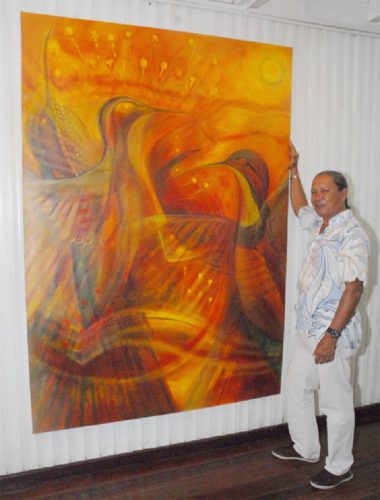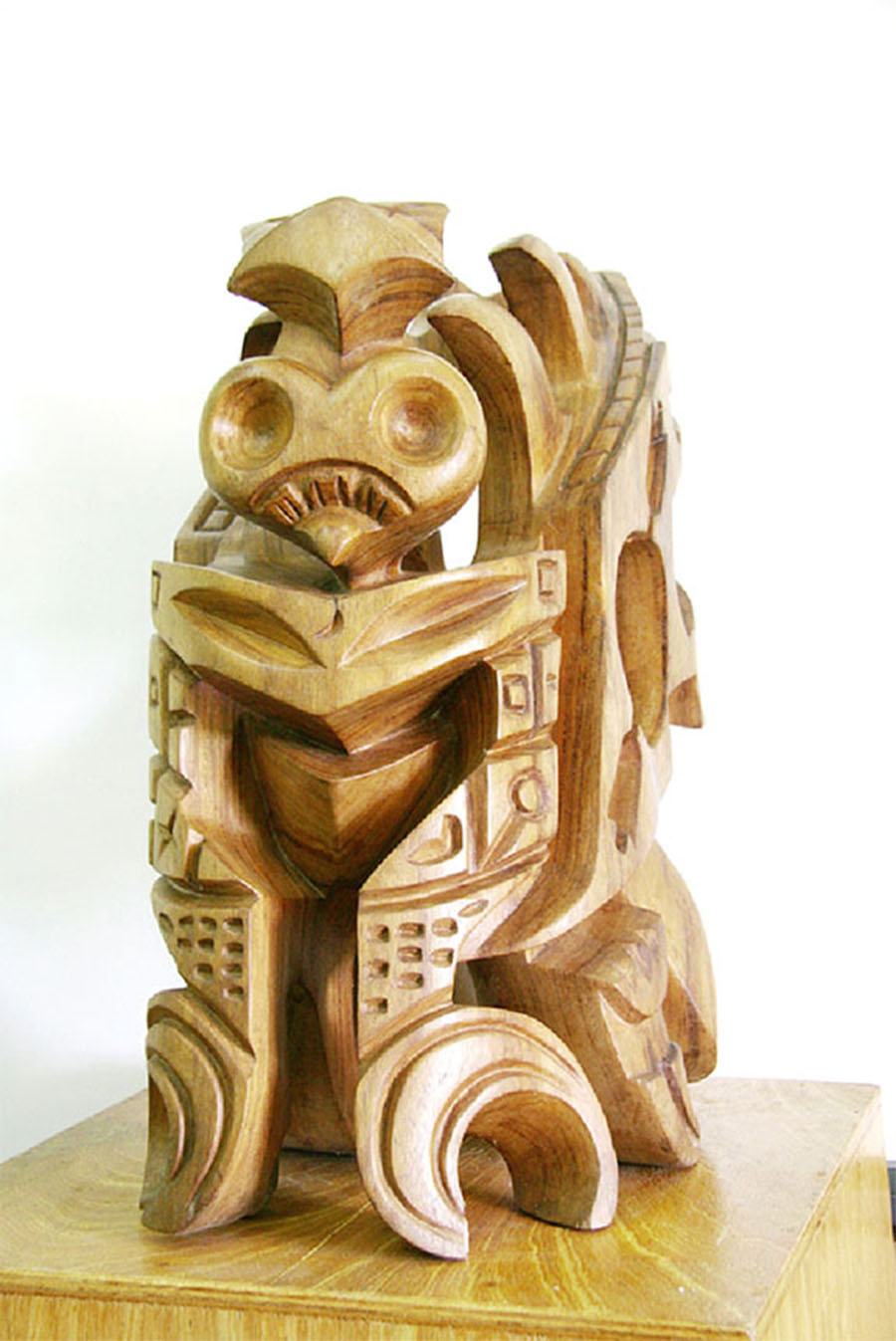
The indigenous people of Guyana produced the oldest surviving forms in pictorial products – petroglyphs, which represented the depth of an artistic product with anthropological function in the nation’s prehistory. These cryptic inscriptions were ancient forms of survival and human progress produced by the people themselves. They were followed by a long colonial period characterised by the work of expatriates. Interestingly, these predominantly nineteenth century sketches of Amerindian village life and botanical specimens, inter alia, had scientific, anthropological and historical value, but were produced by outlanders and focused on Amerindians only as subject. Ironically, in modern times when local artists began to advance art it was to a revisit of the ancient rock drawings and tribal motifs that they first turned. Such were the investigations in paintings by Aubrey Williams and the varied works of Marjorie Broodhagen. Amerindian art moved into abstract work.

Another important movement included the development involving native Amerindians as artists themselves, with the rise of Stephanie Correia, Anna Correia and George Simon. Yet, still, there was a mixture because local artists returned to prehistory in two ways – with descriptive realism as in Simon’s large canvases, and a preoccupation with ancient motifs as in Correia’s ceramics and paintings. There was also rising interest in mythology and old Amerindian traditions and tales. After and alongside Correia, the Lokono artists moved with interrogating depth further into the ethos, ethnic identity, myth, spiritualism, animism and belief. Simon, Winslow Craig and Oswald Hussein have largely been responsible for abstract art and postmodernism.
An analysis of contemporary art must take into consideration the different interests of Craig, currently a lecturer at the University of Guyana, a reputed researcher, whose directions move separately from the dominant Lokono sculptors. He came to prominence with a characteristic style of highly polished wood carvings, exploring various subjects. He is precise, but produces abstract work that is exciting and commands a fantastic output of the imagination.
Apart from working in wood, Craig explores creations in metal and has accumulated a considerable collection in that medium, influenced by work in New Zealand. More recently, he extended the use of metals into postmodernist mixed media. But, perhaps also influenced by a period enabled by a fellowship in Belize, he, too, revisits ancient ethnic traditions. He remains conversant with the Amerindian cosmos and has produced sculptures demonstrating that. Probably foremost among these excursions is his undertaking of a major project concerning the production of a large, tree-sized totem pole, which so far remains unfinished.
A return to the totem pole has been a fairly minor feature in public art produced by Amerindian artists. Noteworthy in this is the recent work of Telford Taylor of St Cuthbert’s Village who rose to prominence in the exhibition of “Six Lokono Artists” (1996). Taylor’s significant exhibit stands on the lawns of the Walter Roth Museum of Anthropology and Archaeology in Georgetown.
Simon, who developed and led the school of Lokono artists, was also involved in public art, but apart from a famous mural on the University of Guyana Turkeyen Campus does not have many remaining pieces on show. As far as Amerindian art is concerned, one of his works with mythological themes used to be the backdrop to the stage of the Umana Yana building, but was destroyed by fire some years ago.
Simon’s UG mural “Palace of the Pea-cock: Homage to Wilson Harris” (2009) is important as an exhibit of Amerindian art, although painted by a team that included Philbert Gajadhar and Anil Roberts. The painting contains characteristics of both Simon and contemporary Amerindian art, including the Kanaima influence, animism and the motifs of the rainforest. Simon’s paintings demonstrate these, particularly the postmodernist feature in the use of the spots/stripes of the jaguar, which is a shape-shifter in the form of the skilled hunter. Along with that is the use of the spots, the ‘eyes’ on the amazingly spectacular tail of the peacock. Such shape-shifting represented in paint is a characteristic of the art and especially of Simon.
The quality of his work has been analysed in these pages, but many other accounts have been published by artist and critic Alim Hosein of UG, and artist, art historian and columnist Akima McPherson, who is the Coordinator of Creative Arts at UG. Simon is extraordinarily original in his employment of such elements as shape-shifting and his explorations into the imagination, but he has created identifiable Amerindian art. At the core of some of his later work are his excursions into mythology and spiritualism, especially “The Shaman’s Journey Along the Milky Way”, which is based on a myth that influenced him undertaking a shaman’s journey, which included visits to the UK, Sudan and Haiti. This is responsible for a significant phase in Simon’s painting. Another such was his last phase rooted in the environment with a preoccupation with trees and roots. Many later paintings reflect a cross-culturalism involving myths and spiritualism in Guyana and Haiti.
Spiritualism, animism and the forest are major characteristics of Amerindian art, notwithstanding Simon’s innovative application of them, and sometimes his exclusive deployment of them. His former student, Linus Klenkian, a Lokono sculptor, sustains a special relationship with the environment which is relevant to his art. There is a spiritual oneness with the forest, which affects his selection of wood for carving. This causes each piece of his art work to be almost possessed in this way as he explains it.
This empathy with the landscape and the environment is explained by Klenkian as a living reality experienced by him. But it is a general characteristic of and carries over into the art of Lokono sculptors such as Hussein. Pieces of work express the elements mentioned above in relation to Simon. Hussein, in particular, transmits oneness with the forest and its creatures and the supernatural – such as the almost terrifying bird spirits found in some of his sculptures.
Some of these spirits are described by villagers as inhabitants of the forest who can be shape-shifters, appearing as birds or other animals. There is also a unity with the environment such as that described by novelist Pauline Melville in her portrait of the hunter and the power of ventriloquism. There are many stories of humans who can transform themselves.
These beliefs, which are consistent with the cosmology, the world picture and then ethnic identity manifest themselves in the work of artists. These have been characteristic of the art since Williams in the 1950s and his engagement of petroglyphs, motifs and the Amerindian ethos with which he came into contact in the North-West. He produced art which was seriously able to reflect this.
The mythology, traditional ways of life and beliefs that artists made much more than superficial visual use of, deepened Amerindian art which has claimed a major place in Guyanese art over the past 40 years.






